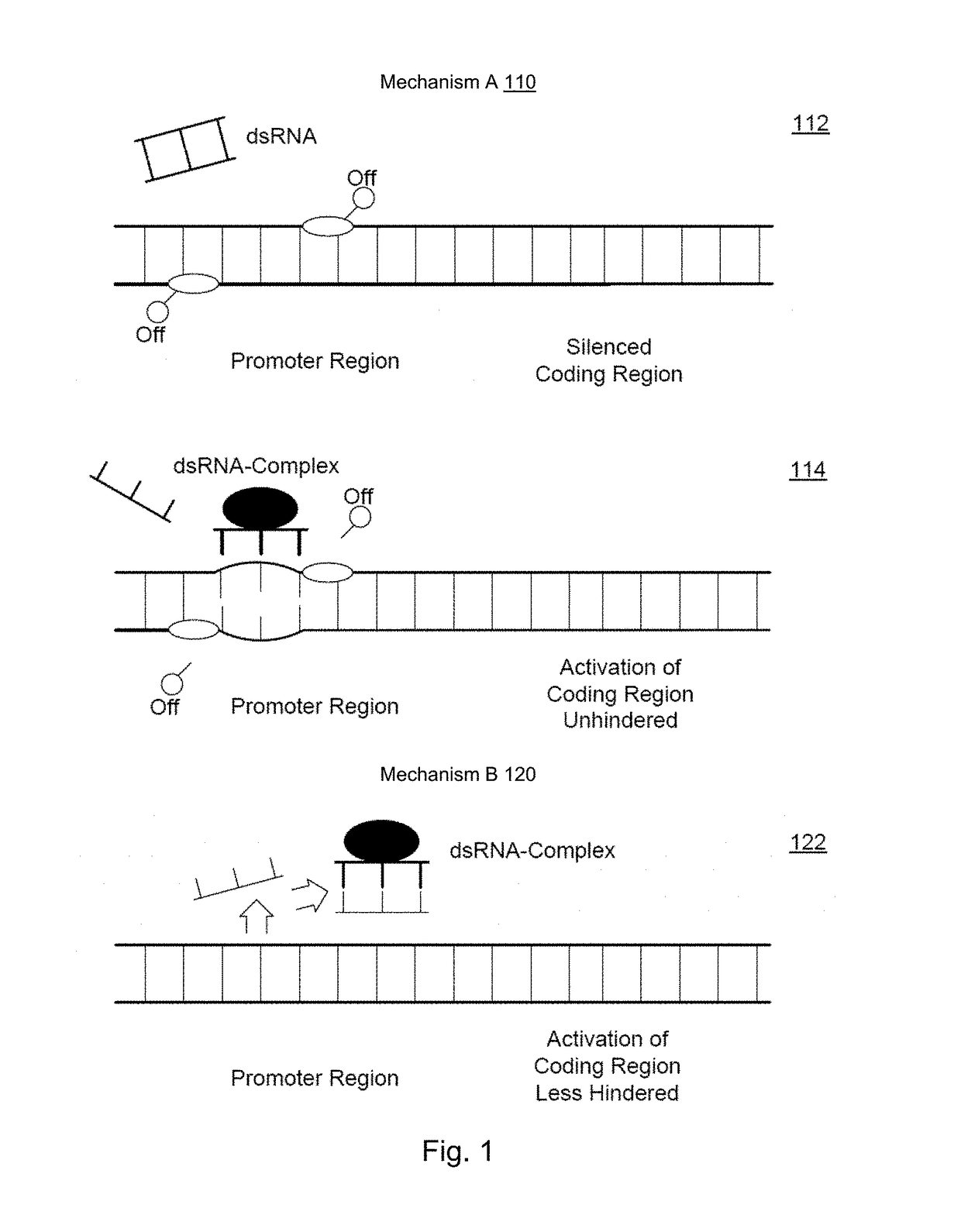Albumin production and cell proliferation
a cell proliferation and albumin technology, applied in the field of upregulating albumin production, can solve the problems of mrna cleavage and destruction, and the inability to translate mrna into protein,
- Summary
- Abstract
- Description
- Claims
- Application Information
AI Technical Summary
Benefits of technology
Problems solved by technology
Method used
Image
Examples
example 1
Designing Short RNAs for Upregulating Albumin Expression
[0281]The gene sequences of genes involved in albumin production were selected for designing short activating RNA molecules for its specific activation. Particularly suitable are the albumin gene, the CEBPA gene and / or the HNF4α gene.
[0282]Four parameters were used: 1) targeting gene annotations from UCSC RefSeq database; 2) targeted sequence from antisense RNA; 3) promoter selection of antisense sequences; and 4) identification of candidate short activating RNAs.
[0283]First, the method downloads information about the target's genomic location, orientation, and transcriptional structure from available databases (RefSeq at UCSC). Second, given a database of RNA transcripts with known read direction, such as the UCSC Spliced EST track, our method searches the database for transcripts that are antisense to and in the vicinity of the target gene. More specifically, the method identifies antisense transcripts that (a) overlap the ta...
example 2
Upregulation of Albumin Expression Through Transfection with Albumin saRNA
Materials and Methods
[0285]25 nM of annealed Albumin saRNA designed as described in Example 1 was transfected onto a monolayer of cell using Nanofectamine (PAA, UK) following the manufacturer's instructions. This process was repeated three times. The sequences of the saRNA that were used for this study were human albumin PR1 (SEQ ID NO:5 and SEQ ID NO:6), human albumin PR2 (SEQ ID NO:7 and SEQ ID NO:8), human albumin PR3 (SEQ ID NO:9 and SEQ ID NO:10) and human albumin PR4 (SEQ ID NO:11 and SEQ ID NO:12), as shown in Table 1. A random, scrambled RNA molecule was used as control.
[0286]After transfection, the isolation of total RNA was performed using the RNAqueous-Micro kit (Ambion, UK) following the manufacturer's instructions. Briefly, the cells were gently centrifuged followed by 3 pulses of sonication at Output 3 in Lysis buffer (Ambion, UK). The cell lysates were then processed through an RNA binding colum...
example 3
Inhibition of the Proliferation of Cells Through Transfection with Albumin saRNA
[0291]HepG2 cells and rat liver epithelial cells were transfected with albumin saRNAs as described in Example 2, i.e. the same saRNAs were used in this Example as in Example 2. Cell proliferation within the rat liver epithelial cells and HepG2 cells respectively was measured using the WST-1 proliferation assay. Briefly, the cell proliferation reagent tetrazolium salt, 4-[3-(4-iodophenyl)2-(4nitrophenyl)2H-5-tetrazolio]1,3benzene disulfonate (Roche Applied Science, UK) was added (e.g., following the manufacturer's instructions). The colorimetric assay was then incubated for 30 minutes to allow cleavage of the tetrazolium salt WST-1 to a formazan dye by mitochondrial succinate-tetrazolium reductase in viable cells. The quantity of formazan dye, which is directly related to the number of metabolically active cells proliferating was measured at Amax450 nm in a multiwall plate reader.
[0292]Cell proliferation ...
PUM
| Property | Measurement | Unit |
|---|---|---|
| temperature | aaaaa | aaaaa |
| pH | aaaaa | aaaaa |
| volume | aaaaa | aaaaa |
Abstract
Description
Claims
Application Information
 Login to View More
Login to View More - R&D
- Intellectual Property
- Life Sciences
- Materials
- Tech Scout
- Unparalleled Data Quality
- Higher Quality Content
- 60% Fewer Hallucinations
Browse by: Latest US Patents, China's latest patents, Technical Efficacy Thesaurus, Application Domain, Technology Topic, Popular Technical Reports.
© 2025 PatSnap. All rights reserved.Legal|Privacy policy|Modern Slavery Act Transparency Statement|Sitemap|About US| Contact US: help@patsnap.com



